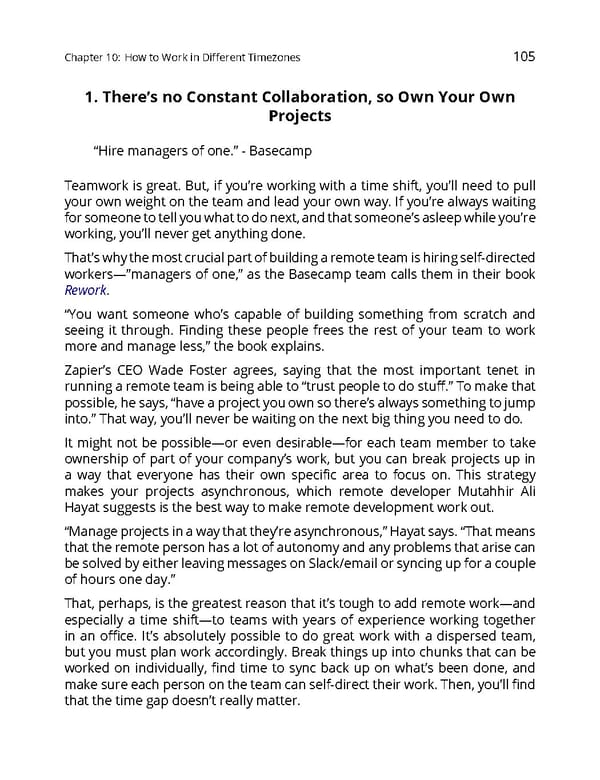Chapter10: HowtoWorkinDifferentTimezones 105 1. There’s no Constant Collaboration, so Own Your Own Projects “Hire managers of one.” - Basecamp Teamwork is great. But, if you’re working with a time shift, you’ll need to pull your ownweightontheteamandleadyourownway.Ifyou’realwayswaiting forsomeonetotellyouwhattodonext,andthatsomeone’sasleepwhileyou’re working, you’ll never get anything done. That’swhythemostcrucialpartofbuildingaremoteteamishiringself-directed workers—”managers of one,” as the Basecamp team calls them in their book Rework. “You want someone who’s capable of building something from scratch and seeing it through. Finding these people frees the rest of your team to work moreandmanageless,”thebookexplains. Zapier’s CEO Wade Foster agrees, saying that the most important tenet in runningaremoteteamisbeingableto“trustpeopletodostuff.”Tomakethat possible,hesays,“haveaprojectyouownsothere’salwayssomethingtojump into.” That way, you’ll never be waiting on the next big thing you need to do. It might not be possible—or even desirable—for each team member to take ownership of part of your company’s work, but you can break projects up in a way that everyone has their own specific area to focus on. This strategy makes your projects asynchronous, which remote developer Mutahhir Ali Hayatsuggestsisthebestwaytomakeremotedevelopmentworkout. “Manageprojectsinawaythatthey’reasynchronous,”Hayatsays.“Thatmeans thattheremotepersonhasalotofautonomyandanyproblemsthatarisecan besolvedbyeitherleavingmessagesonSlack/emailorsyncingupforacouple of hours one day.” That, perhaps, is the greatest reason that it’s tough to add remote work—and especially a time shift—to teams with years of experience working together in an office. It’s absolutely possible to do great work with a dispersed team, but you must plan work accordingly. Break things up into chunks that can be worked on individually, find time to sync back up on what’s been done, and makesureeachpersonontheteamcanself-directtheirwork.Then,you’llfind that the time gap doesn’t really matter.
 The Ultimate Guide to Remote Work Page 108 Page 110
The Ultimate Guide to Remote Work Page 108 Page 110